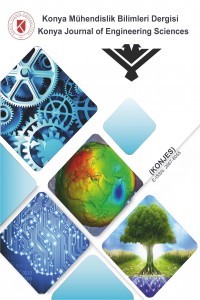Modifiye Fenton Prosesi ile Azo Boyaların Dekolorizasyonu
Bu çalışmada C.I. Reaktif Orange 127 (RO 127) ve C.I. Reaktif Yellow 145 (RY 145) boyalarının modifiye edilmiş Fenton prosesi (Fe0/H2 O2 ) ile renk giderimi araştırılmıştır. Deneylerde optimum çalışma koşullarının belirlenmesi için pH, Fe0 ve H2 O2 konsantrasyonu için çalışma yürütülmüştür. Bu çalışmada azo boya ve polivinil alkol (PVA) içeren sentetik tekstil atıksuyunun renksizleştirilmesinde modifiye edilmiş Fenton prosesinin verimli bir uygulama olduğunu göstermektedir. Optimum çalışma koşullarının belirlenmesi için yapılan deneylerde RO 127 için pH=3.5, [H2 O2 ] = 20 mg/L, [Fe0]= 80 mg/L ve RY 145 için ise pH = 4.0, [H2 O2 ] = 20 mg/L, [Fe0] = 60 mg/L tespit edildi. Belirlenen optimum şartlar altında 60 dakikalık temas süresinde RO 127 ve RY 145 için sırasıyla %92 ve %80 oranında renk giderimi sağlanmıştır.
Anahtar Kelimeler:
Renk giderimi, Fenton prosesi, Demir tozu, RY 145, RO 127
DECOLORIZATION OF AZO DYES BY MODIFIED FENTON PROCESS
In the present study, the decolorization of C.I. Reactive Orange 127 (RO 127) and C.I. Reactive Yellow 145 (RY 145) by modified-Fenton process (Fe0/H2 O2 ) was investigated. The experiments were carried out to determine the process’s optimal operational conditions: pH, Fe0 and H2 O2 concentrations. This study shows that modified Fenton process is an efficient process for the decolorization of synthetic textile wastewater including azo dye and polyvynil alcohol (PVA). The optimal conditions experimentally determined was found to be initial pH = 3.5, [H2 O2 ] = 20 mg/L, [Fe0]= 80 mg/L for RO 127 and pH = 4.0, [H2 O2 ] = 20 mg/L, [Fe0] = 60 mg/L for RY 145. Under the optimal conditions, 92% and 80% decolorization were achieved after 60 min of reaction for RO 127 and RY 145, respectively.
Keywords:
Decolorization, Fenton’s process, iron powder, RY 145, RO 127.,
___
- Al-Degs, Y., Khraisheh, M.A.M., Allen, S.J., Ahmad, M.N., 2000, “Effect of carbon surface chemistry on the removal of reactive dyes from textile effluent”, Water Res., 34, 927-935.
- Arslan, I., Akmehmet, B.I., Tuhkanen, T., 1999, “Oxidative treatment of simulated dyehouse effluent UV and near-UV light-assisted Fenton’s reagent I”, Chemosphere, 39, 2767-2783.
- Azbar, N., Yonar, T., Kestioglu, K., 2004, “Comparison of various advanced oxidation processes and chemical treatment methods for COD and color removal from a polyester and acetate fiber dyeing effluent”, Chemosphere, 55, 35-43.
- Gallard, H., Laat, J.D., Legube, B., 1998, “Influence du pH sur la vitesse d’oxydation de composès organiques par FeII/H2O2. Mécanismes reactionnels et modélisation”, New J. Chem., 263-268. Grau, P., 1992, “Textile industry wastewater treatment”, Water Sci. Tech., 24, 97-103.
- Kang, S.F., Liao, C.H., Chen, M.C., 2002, “Pre-oxidation and coagulation of textile wastewater by the Fenton process”, Chemosphere, 46, 923-928.
- Kwon, B.G., Lee, D.S., Kang, N., Yoon, J., 1999, “Characteristics of p-chlorophenoloxidation by Fenton’s reagent”, Water Res., 33, 2110-2118.
- Lin, S.H., Lai, C.L., 2000, “Kinetic characteristic of textile wastewater ozonation in fluidized and fixed activated carbon belts”, Water Res., 34, 763-772.
- Morais, L.C., Freitas, O.M., Goncalves, E.P., Vasconcelos, L.T., Beca, C.G.G., 1999, “Reactive dyes removal from wastewaters by adsorption on eucalyptus bark: variables that define the process”, Water Res., 33, 979-988.
- Nillson, R., Nordlinder, R., Wass, U., 1993, “Asthma, rhinitis, and dermatitis in workers exposed to reactive dyes”, Br. J. Ind. Med., 50, 65-70.
- Ozdemir, C., Sahinkaya, S. and Onüçyıldız, O., 2008, “Treatment of Pesticide Wastewater by Physicochemical and Fenton Processes”, Asian Journal of Chemistry, 20(5), 3795-3804.
- Sahinkaya, S., Aygun, A., Sevimli, M.F., “The Application of Fe0/H2O2 for Color Removal” VIIIth International Scientific Conference, SGEM, Conference Proceeding, Albena, 1, 803-811, 16-20 June 2008, Albena-Varna/Bulgaria.
- Tunay, O., Kabdaşlı, I., Orhon, D., Eremektar, G., 1996, “Color removal from textile wastewater”, Water Sci. Technol., 34, 9-16.
- Walling, C. ,1975,. “Fenton’s reagent revisited”, Acc. Chem. Res., 8, 125-131.
- Zhang, H., Zhang, J., Zhang, C., Liu, F., Zhang, D., 2009, “Degradation of C.I. Acid Orange 7 by the advanced Fenton process in combination with ultrasonic irradiation”, Ultrasonics Sonochemistry, 16, 325-330.
- Yayın Aralığı: Yılda 4 Sayı
- Başlangıç: 2004
- Yayıncı: Konya Teknik Üniversitesi
